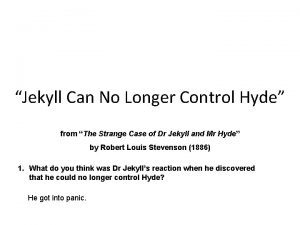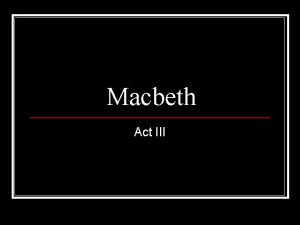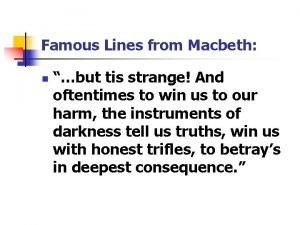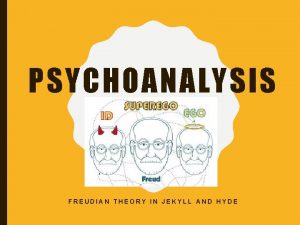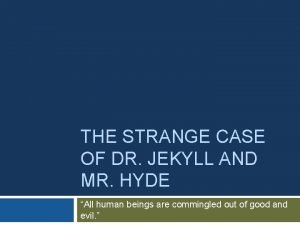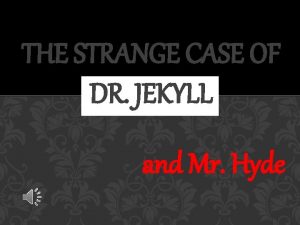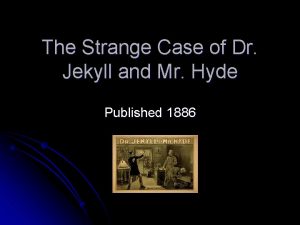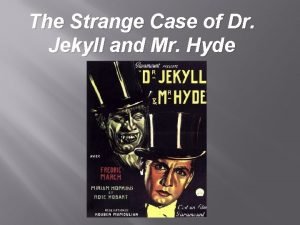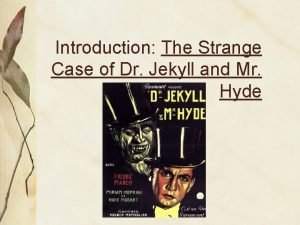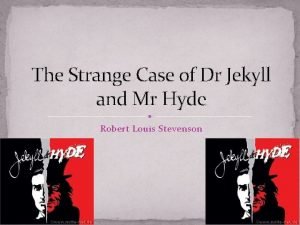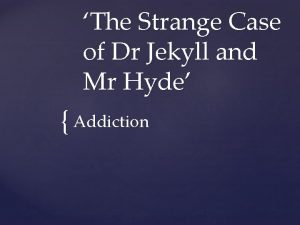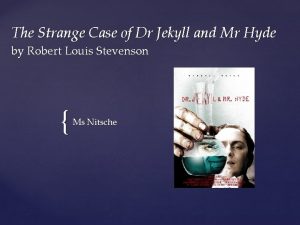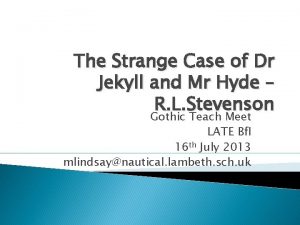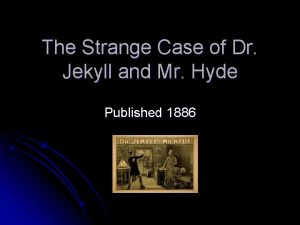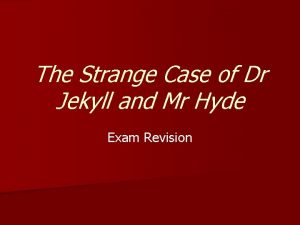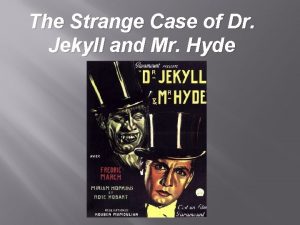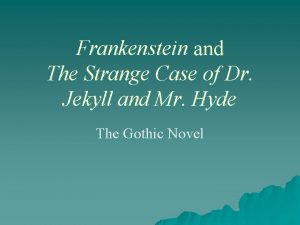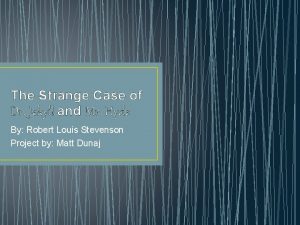The Strange Case of Dr Jekyll and Mr
















- Slides: 16

The Strange Case of Dr Jekyll and Mr Hyde Robert Louis Stevenson Learning Objectives: To understand what life was like during Victorian England; To be able to make inferences about the period based on artistic interpretations AO 3: Show understanding of the relationships between texts and the contexts in which they were written

Why is contextual awareness important? • Stevenson’s writing was clearly influenced by events which took place both in London and Edinburgh during his life time. He was also undoubtedly very aware of the rising tensions between scientific theories and traditional religion during the Victorian era. We can make many links between the portrayal of the characters, the settings and the events in the story and what was currently high profile in the society of the time. • Look through the information on these slides and make a record of key points- either through answering the questions on the next slide or doing a more extensive context page.

A 03 Context What do you know? 1. 2. 3. 4. Where and when was Stevenson born? Who was Deacon Brodie and why is he relevant to the story ‘Jekyll and Hyde? ’ When and where is the book set? Who was on the throne when the book was published and what were some of the important morals of this era? 5. Which murderer is linked to Mr Hyde in 1888 and why? 6. What did Darwin’s Theory of Evolution suggest and when was it published? How does it relate to the story? 7. Which gothic novels were written in 1800 s? 8. What characterises gothic literature? 9. What were some of the problems in London when the book was published? 10. What theory did the scientist Freud propose that links to Jekyll and Hyde and when? How does it link to the story? 11. Who were Burke and Hare and Dr. Knox? 12. What was the name of Lombroso’s theory and How is Lombroso’s theory relevant to the story? Use the information on the following slides to help you answer these questions. It would be even better if you did a double spread context page, as you did for ‘Blood Brothers’

Robert Louis stevenson Robert Louis Balfour Stevenson (13 November 1850 – 3 December 1894) was a Scottish novelist, poet, essayist, and travel writer. His most famous works are Treasure Island, Kidnapped, Strange Case of Dr Jekyll and Mr Hyde (published in 1886 and based in Victorian London) The author was born in Edinburgh, Scotland, in 1850. His family included engineers, scientists, a professor of philosophy, and a religious minister. We can see the scientific and religious sides of Stevenson's family reflected in both his life and Dr Jekyll and Mr Hyde. Stevenson was a sickly child (he had serious lung problems) who read a great deal about travel and adventure. A combination of his love of adventure and ill health led him to spend many years as a writer travelling the world in search of a climate that was healthier than Britain's. In 1890, he went to live in the remote Samoan Islands in the South Pacific. He died there in 1894 at the age of 44

Queen Victorian morality is a distillation of the moral views of people living at the time of Queen Victoria's reign (1837– 1901) and of the moral climate of the United Kingdom of the 19 th century in general. Today, the term "Victorian morality” = sexual restraint, low tolerance of crime and a strict social code of conduct. The morality and values of the period can be classed as Religion, Morality, Elitism, Industrialism, and Improvement. Historians now regard the Victorian era as a time of many contradictions, such as the widespread cultivation of an outward appearance of dignity and restraint together with the prevalence of social phenomena such as prostitution and child labour.

Victorian London Consider how these images convey life for people of different classes in Victorian London

Victorian Edinburgh

Gothic literature • Gothic fiction, which is largely known by the subgenre of Gothic horror, is a genre or mode of literature and film that combines fiction and horror, death, and at times romance. • Its origin is attributed to English author Horace Walpole, with his 1764 novel The Castle of Otranto, subtitled (in its second edition) "A Gothic Story". • The effect of Gothic fiction feeds on a pleasing sort of terror • It originated in England in the second half of the 18 th century and had much success in the 19 th, as witnessed by Mary Shelley’s Frankenstein and the works of Edgar Allan Poe. Another well known novel in this genre, dating from the late Victorian era, is Bram Stoker’s Dracula. • The name Gothic refers to the (pseudo)-medieval buildings, emulating Gothic architecture, in which many of these stories take place. This extreme form of romanticism was very popular in England • Gothic literature is also known for its exploration of deep emotional anxiety and turmoil. • Characterised often by settings that include moonlight, castles, fog, wolves, supernatural forces

Charles Darwin In 1859, Charles Darwin published The Origin of Species. It became famous for introducing the Theory of Evolution to the public. Many people saw it as an attack on religion, because the book made it impossible to believe that God created the world in 7 days. Science vs. Religion? Darwin put forward theory that all life, including humans, had evolved from more primitive forms. This created a division within Victorian society; many felt that they had to choose between the two. Those that opted for religion held the belief that science had become dangerous and was meddling in matters which only God had control over.

Although his theories didn’t became popular until the 1900 s we can apply Freud’s theory to the 2 sides of Jekyll and Hyde. Freud's psycho analytic theory of personality argues that human behaviour is the result of the interactions among three component parts of the mind: the id, ego, and superego. Freud argued that the human mind and personality are made up of three parts: ID A primitive part of the personality that pursues only instant pleasure and gratification EGO Part of the personality that is aware of reality and is in contact with the outside world. Considers the consequences of an action and deals with the demands of the id and superego SUPEREGO Contains our social conscience and through the experience of guilt and anxiety when we doing something wrong – guides us towards socially acceptable behaviour. Hyde!! Jekyll Victorian society

Deacon Brodie • William Brodie (28 September 1741 – 1 October 1788), more commonly known by his prestigious title of Deacon Brodie • Scottish cabinet-maker, deacon of a trades guild, and Edinburgh city councillor • Had a secret life as a burglar, partly for the thrill, and partly to fund his gambling • Robert Louis Stevenson’s father owned furniture made by Brodie • Stevenson was fascinated by the dichotomy between Brodie's respectable façade and his real nature and was inspired to write The Strange Case of Dr. Jekyll and Mr. Hyde (1886). [ Read more at: http: //www. bbc. co. uk/news/uk-scotland 31018496

Jack the Ripper • • • Someone in London murdered and mutilated a number of prostitutes during the autumn of 1888; the press went into a frenzy, politicians pointed the finger at each other, hoaxers polluted the investigation and one of several nicknames stuck: Jack the Ripper. Over a century later Jack's identity has never been wholly proven. Jack the Ripper became a prominent figure during the Victorian era due to his anonymous identity and the violence of his crimes – he epitomised the criminal activity of the era: dangerous and uncontained. Anxieties of the period were heightened and society as a whole, began to feel an sense of danger and insecurity.

LOMBROSO • An 'atavism' is an evolutionary throwback to more primitive times. Specifically, it's a person who has not developed at the same pace as the rest of society. Atavism is a term associated with biological theories of crime and Cesare Lombroso of the Italian school of criminology in the late 1800 s. • Hyde shows clear ‘atavistic’ characteristics in the way he is physically described by Stevenson. Cesare Lombroso was an Italian criminologist, physician, and founder of the Italian School of Positivist Criminology. Lombroso rejected the established classical school, which held that crime was a characteristic trait of human nature. Instead, using concepts drawn from physiognomy, degeneration theory, psychiatry and Social Darwinism, Lombroso's theory of anthropological criminology essentially stated that criminality was inherited, and that someone "born criminal" could be identified by physical (congenital) defects, which confirmed a criminal as savage or atavistic

Burke and Hare the Edinburgh body snatchers! Bodies were needed for medical research Hanged criminals’ bodies were donated to medical schools There were not enough bodies – body snatching! Only Burke was convicted of murder and was consequently executed – his body was donated to medical science and his skin made into a pocketbook! Last victim – Mrs Docherty - body found under straw mattress Burke and Hare Irish – moved to Edinburgh – lodged with women of low virtue – lived in a run down area Body snatching became so profitable Burke and Hare sought out people to murder and sell on! Dr. Knox bought bodies and used them in his medical school …no questions asked! The Old Town – White Hart Inn Watched for possible victims and lured them to their deaths – strangled so as not to damage bodies for medical research

John hunter – parallels to Jekyll and his house • John Hunter was a Scottish surgeon, one of the most distinguished scientists and surgeons of his day. He was an early advocate of careful observation and scientific method in medicine. He was an expert in anatomy and built up a huge collection of anatomical specimens at his premises in London. • Hunter’s house was possibly the model for Dr Jekyll’s residence in Strange Case of Dr Jekyll and Mr Hyde. His experimental methodology, which included animal vivisection, brought into surgical practice procedures which were alarming to the medical establishment of the day, but which saved many lives in a period before anaesthetics and antiseptics. As a result of his success he achieved great renown, and kept a house in Leicester Square which was frequented by the great and good of the time; he was also surgeon to the King. However, his success and methods brought him many detractors. • In order to teach and to gain knowledge about human anatomy, Hunter required human cadavers (bodies), many of them supplied by grave robbers. These were brought, at night, to the back entrance of the house, which had a drawbridge, leading to the preparation rooms and lecturetheatre. Jekyll’s laboratory (cabinet) is at the back of the house. Stevenson, in describing the house in the novel, with preparation rooms and lecturing theatre, holds open the possibility of a connection to Hunter. • The previous owner of Jekyll's house is elsewhere named as ‘Dr Denman’. Dr Thomas Denman was a contemporary of John Hunter, celebrated for his pioneering work in obstetrics.

As we are reading ‘The Finest Horror Story in our Language’ You may wish to keep a glossary of some new vocabulary words you come across. The vocabulary is challenging and outdated for the modern reader – here are some words which may be new to you! Doppelganger - identical double Juggernaut - Statue of the Hindu god Krishna that is pulled by a chariot and religious devotees throw themselves under it to be killed. Abominable - adj. horrible austere - adj. severe, stern Conflagration - n. raging fire Demeanour - n. manner/personality eddy - n. whirlpool Negligence - n. carelessness odious - adj. horrid perplexity - n. confusion sedulously - adv. tirelessly sullenness - n. gloominess Troglodyte - cave-dwelling person
 When is jekyll and hyde set
When is jekyll and hyde set Dr jekyll and mr hyde summary
Dr jekyll and mr hyde summary Dr jekyll and mr hyde chapter 4
Dr jekyll and mr hyde chapter 4 The strange case of beriberi answers key
The strange case of beriberi answers key Best worst and average case
Best worst and average case Macbeth hires murderers to kill banquo
Macbeth hires murderers to kill banquo Limitations of the strange situation
Limitations of the strange situation Famous lines of macbeth
Famous lines of macbeth Jekyll and hyde psychoanalysis
Jekyll and hyde psychoanalysis Jekyll and hyde key quotes
Jekyll and hyde key quotes Difference between short case and long case
Difference between short case and long case Binary search performance
Binary search performance Bubble sort best case and worst case
Bubble sort best case and worst case Bubble sort best case and worst case
Bubble sort best case and worst case Bubble sort best case and worst case
Bubble sort best case and worst case Ambiguous triangle
Ambiguous triangle Hát kết hợp bộ gõ cơ thể
Hát kết hợp bộ gõ cơ thể

